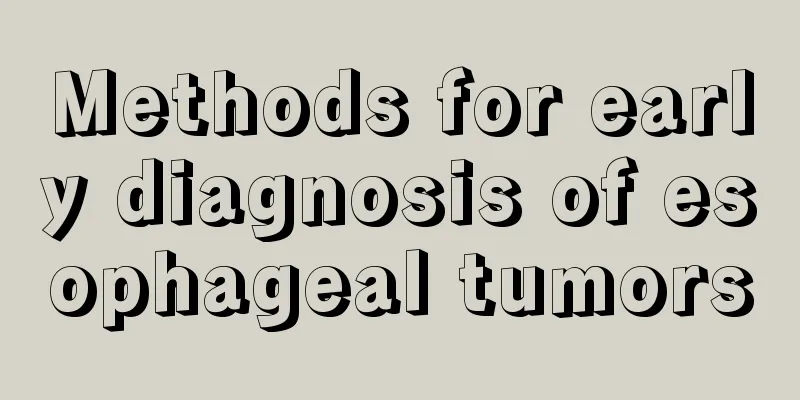Methods for early diagnosis of esophageal tumors

|
There has been great progress in the research of early diagnosis of esophageal tumors, but most patients still cannot be diagnosed in the early stage. The early diagnosis of esophageal tumors has always been a difficult problem because the early symptoms are not obvious, and patients ignore the symptoms and delay the treatment. Among them, there are several clinical methods for early diagnosis of esophageal tumors: 1. Esophageal tuberculosis It is a type of specific inflammation and is rare in clinical practice. Mild lesions may be asymptomatic. If they are proliferative or form tuberculomas, they may cause varying degrees of obstruction or difficulty in swallowing, or even pain. The course of the disease progresses slowly, and there are more young and middle-aged patients with combined medical history. X-rays show esophageal lumen stenosis and ulcers, and irregular esophageal contours. The final diagnosis of esophageal tuberculosis depends on esophageal cytology or esophagoscopy. Effective anti-tuberculosis treatment is one of the methods for differential diagnosis. Second, extraesophageal pressure changes refer to compression and dysphagia caused by abnormalities of organs adjacent to the esophagus. Common ones include large vessel malformations, mediastinal tumors, enlarged or calcified hilar and mediastinal lymph nodes, intrathoracic thyroid enlargement, and flexion and extension of the aortic arch in the elderly. Although the patient has a sense of swallowing obstruction, the esophageal mucosa is intact. In addition, the degree of dysphagia caused by these extraesophageal factors is relatively mild and the disease lasts for a long time. 3. Esophagitis is mainly caused by trauma or bacterial infection. When the esophagus is inflamed, the esophageal wall becomes congested and edematous. The mucosa may become necrotic, eroded, or even ulcerated. The patient complains of discomfort when swallowing, pain or choking when swallowing, and the pain may worsen when swallowing hot or irritating food. These symptoms are very similar to those of early esophageal tumors. However, the difference is that there are often no typical symptoms of dysphagia, food swallowing is not restricted, symptoms are not alleviated when food is accompanied by soup, and there are no symptoms of vomiting or food reflux. X-ray manifestations show localized mucosal interruption, thickening, irritability of the esophageal cavity, and even niches of varying sizes or filling defects. This manifestation will change during short-term follow-up. In esophageal cytology, there are more inflammatory cells in the picture, but no tumor cells. 4. Abnormal esophageal function, such as neurogenic dysphagia (myasthenia gravis, medullary and pseudo-medullary lesions, etc.), may cause dysphagia of varying degrees, but often have systemic symptoms or other unique signs. Achalasia. It is caused by the failure of the esophageal cardia sphincter to relax normally. When the patient eats, the food swallowing is stagnant and cannot enter the stomach through the cardia, resulting in difficulty in swallowing food, stuffiness and obstruction behind the sternum, or a foreign body adhesion after eating, or even dysphagia and food reflux. However, these symptoms often appear alternately, sometimes light and sometimes heavy, with a long course of disease, and have a certain relationship with mental tension. The patient's nutritional status is good and the average age is also relatively young. X-ray examination can find that the barium is weakened or disappears due to the slow peristalsis of food and the passage of time, there is a smooth mucosa, the cardia is "bird-like" and narrow, and the cytology examination is negative. The above is a brief introduction to the early diagnosis methods of esophageal tumors. I hope it will be helpful to everyone and enable early detection and early treatment. Esophageal tumor: http://www..com.cn/zhongliu/sda/sdzl.html |
<<: Common complications after esophageal tumor surgery
>>: What are the auxiliary diagnoses for esophageal tumors?
Recommend
Is MSG toxic if heated at high temperature?
When we cook, we usually add MSG after the dishes...
What are the causes of esophageal cancer?
Esophageal cancer is a malignant digestive tract ...
The role of cornstarch
Do you know what cornstarch is? This term is comm...
Is 502 glue toxic after it dries?
502 glue is a very widely used glue in our lives,...
What are the symptoms of gastric cancer
What are the symptoms of stomach cancer? Most pat...
Can you drink Matsutake wine after 3 years of soaking it?
When making Matsutake wine, you need to choose fr...
Is lung cancer contagious? Cancer treatment experts tell you it is not
Is lung cancer contagious? Lung cancer is a commo...
What methods are good for preventing melanoma
Melanoma is a type of skin disease. Many people t...
Can optic nerve ischemia be cured?
The optic nerve is a relatively important nerve i...
Instructions for surgical treatment of brain metastases from lung cancer
Brain metastases in lung cancer patients often oc...
What are the symptoms of uterine cancer?
Uterine cancer is one of the most common malignan...
Causes of cold hands and feet and headaches
Cold hands and feet that occur in different seaso...
What are the symptoms of skin cancer
Nowadays, more and more people suffer from skin d...
Nutritional recipes for high school students
High school can be said to be the most important ...
What is the reason why pancreatic cancer patients often experience abdominal distension
Due to unreasonable diet and lifestyle habits, th...









